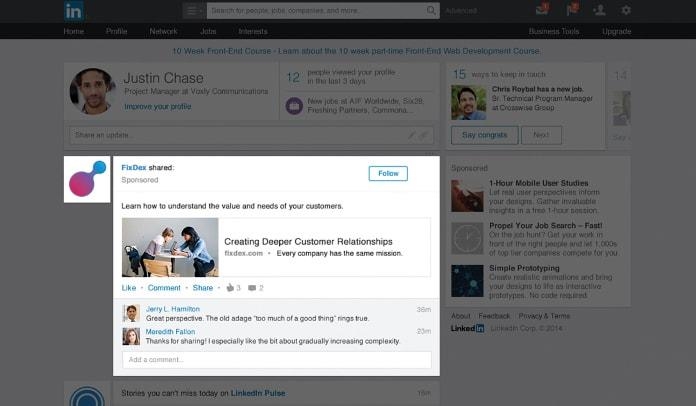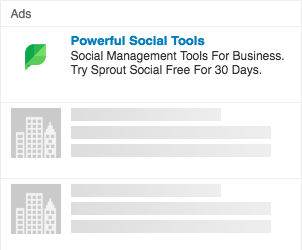LinkedIn Rolls Out Interest Targeting for Advertisers
— January 30, 2019
15% of people love their jobs. The other 85% are either indifferent or miserable.
Indifference and misery seldom translate into engagement. Although you can serve your LinkedIn ads to users based on their careers, you can’t be sure those people like their jobs enough to care.

Engagement like this is hard to come by. Via LinkedIn.
In fact, your LinkedIn prospects may hate their jobs so much that your career-targeted ads actually upset them. Unless you have a working arrangement with Sarah McLachlan, making people upset isn’t going to drive returns.
My point: most people have professional interests outside of their current jobs. For advertisers, that means there’s a ton of potential for serving LinkedIn ads that people actually want to see.
Enter: LinkedIn interest targeting.
What is LinkedIn interest targeting?
The newest feature made available to LinkedIn advertisers, interest targeting gives you the power to serve your ads to exclusive, highly relevant audiences.
It operates according to the same idea as does Facebook interest targeting: although you can’t advertise to consumers while they’re deliberately looking for solutions, you can advertise to the people whose behavior indicates that they’re interested in what you’re offering.
Here’s how it works.
LinkedIn, like Facebook, tracks user behavior. Every time you engage with content—whether it’s through liking, commenting, sharing, or posting—LinkedIn takes note of the subject matter.
If I consistently like and share posts related to social media marketing, LinkedIn determines that it’s an interest of mine. As such, it makes sense for a social media management software like Sprout Social to advertise to me.

Alternatively, Sprout Social could simply advertise to people who list social media marketing as their jobs. Although not a bad tactic, some of those people are far more interested in other professional fields. Some of them would rather see content related to cloud computing.
By leveraging interest targeting, you ensure that your impressions come only from LinkedIn users who’ve demonstrated legitimate interest in your product or service.
How does it compare to Facebook interest targeting?
Here’s how Facebook interest targeting breaks down:
- Business & Industry: advertising, design, retail, etc.
- Entertainment: games, movies, TV, etc.
- Family & Relationships: dating, fatherhood, weddings, etc.
- Fitness & Wellness: meditation, running, weight training, etc.
- Food & Drink: cooking, alcohol, restaurants, etc.
- Hobbies & Activities: current events, travel, politics, etc.
- Shopping & Fashion: beauty, clothing, toys, etc.
- Sports & Outdoors: outdoor recreation, sports
- Technology: computers, consumer electronics
And here’s the brand new suite of LinkedIn interest targeting options:
- Arts & Entertainment: movies, painting, literature, etc.
- Business & Management: company acquisitions, human resources, business law, etc.
- Careers & Employment: retirement, job interviews, hiring, etc.
- Finance & Economy: banking, corporate finances, financial markets, etc.
- Marketing & Advertising: market research, B2B marketing, brand management, etc.
- Science & Environment: earth sciences, climate change, computer science, etc.
- Society & Culture: religion, legislation, charity, etc.
- Technology: telecommunications, robotics, IT infrastructure, etc.
- Health: medical research, public health, healthcare providers, etc.
Although each platform offers nine categories, LinkedIn seems more niche-oriented. As of today, you can advertise exclusively to users who’ve demonstrated interest in earth sciences. When it comes to professional interests, it doesn’t get much narrower than that.

And that’s exactly what you want—the ability to exclude everyone except the small groups of people you’ve declared most relevant. The more focused the group, the more impressions you’ll turn into clicks.
To be clear: we’re not suggesting that you should abandon Facebook targeting altogether. We consistently say the opposite, actually. Facebook interest targeting is just the tip of the iceberg; you can target users based on demographics, behaviors, and connections, too.
As is often the case in digital marketing, the best course of action is to leverage both platforms. Why? Because people use LinkedIn and Facebook differently.
The content users like and share on LinkedIn is very different from the content they like and share on Facebook. If you were to look at someone’s LinkedIn interests and then look at the same person’s Facebook interests, you’d probably think they came from two different people.
Whereas some of your prospects will only show interest in your product or service on LinkedIn, others will only show interest on Facebook. Use interest targeting on both and you’ll seriously boost your lead volume.
Sound good? Get to it!
Digital & Social Articles on Business 2 Community
(47)

